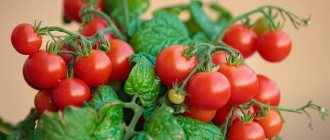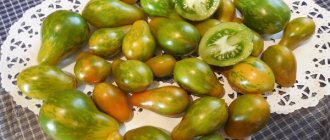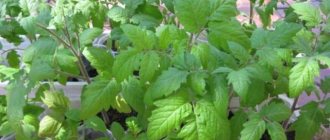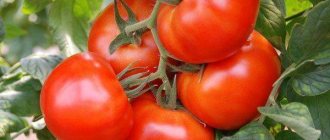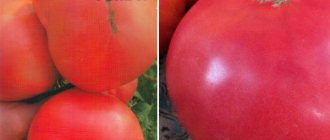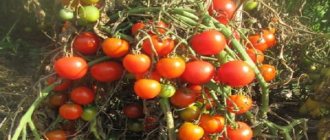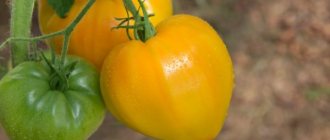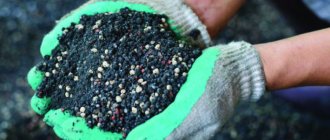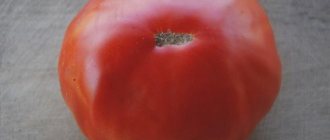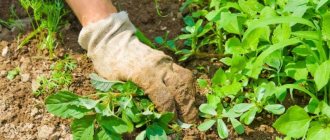As a big tomato connoisseur, I assumed that I had tried or grown almost all the extravagant versions of this vegetable. And shaggy “peaches” tomatoes, and “pepper” tomatoes that are empty inside, and “indecent” tomatoes with a recognizable shape... But it turns out that tomatoes can continue to surprise me. Last year I grew a truly amazing tomato variety called "Stick". I will talk about the extraordinary features of this tomato, its advantages and disadvantages and, most importantly, whether it makes sense to plant it in your beds.
Tomato "Stick" - amazing, unique and... useless? © Lyudmila Svetlitskaya
Description of tomato variety Palka
Tomato Stick has an unusual structure. The bush is columnar in shape and forms several thick stems directed vertically. Plant height is 1.6-1.8 m.
A special feature is the miniature corrugated green leaves
The variety is recommended for greenhouses. In terms of ripening time, it is classified as mid-ripening; the first fruits begin to turn red 120 days after sowing.
Due to the fact that the bush branches slightly and has short leaves, it can be planted very densely, leaving only 20-25 cm between plants. This is especially suitable for small greenhouses. Despite the thickness of the stems, they need garter. The rest of the agricultural technology for the crop is standard.
Palka supplies tomato seed material in packs of 20 seeds. The cost of packaging is several times more expensive than that of conventional varieties. The increased amount of planting material is due to the fact that the variety exhibits instability and deviations may occur during cultivation.
Tomato Palka seedlings are easy to distinguish already at the seedling stage by their special leaves that look as if they have atrophied. In order to clearly see this difference, ordinary tomato seeds are also included in the package.
Tomato Stick is also found under the names:
- curly-leaved;
- Terry-leaved;
- Stick;
- Curl.
Description of fruits
The fruits of the variety are round, smooth, and small in size. Without compaction at the stalk. They grow in short, simple-structured racemes. In one of them 5-6 tomatoes are formed. At the beginning of fruiting, tomatoes grow larger and become smaller toward the top.
The weight of one tomato is from 50 to 100 g. The walls are dense, the skin is not prone to cracking. The taste is ordinary sweet and sour.
Preparing your seeds
As noted in the characteristics of the Palka tomato, this is a variety, not a hybrid. Therefore, it is possible to prepare your own seeds for the next season. Gardeners often ask about how to prepare them, because it’s no secret that seeds in stores are not cheap. And the quality of seed material does not always satisfy gardeners.
Own seeds of a particular variety retain quality. The tomatoes grown correspond to the description and characteristics.
Important! Tomato seeds do not lose their viability for 5 years.
Stages of work:
- To obtain seeds, you need to select ripe fruits that match the shape of the variety. As a rule, the fruits are picked from the second cluster. The best seeds come from so-called female tomatoes: there is a small depression on the bottom of the fruit.
- The tomato should be washed with warm pink water, dissolving potassium permanganate, to remove possible pathogens. For 5 days, the tomatoes are left indoors in a dark and warm place to ripen.
- When the tomato softens a little, cut it with a sterile knife and squeeze out the contents with pulp and seeds into a clean glass, cover with a piece of cotton cloth and leave in a dark place.
Even if there is not enough juice, it is forbidden to add water, otherwise the seeds will die.
- In two days the contents will begin to ferment. You can tell that the seeds are ready for washing by the thin film on the surface and bubbles. The seeds themselves will end up at the bottom.
- Pour warm water into a glass and carefully rinse the seeds. The procedure is repeated until the water becomes clear.
- The seeds are placed on a cotton cloth to remove moisture. Then they are laid out on white paper in one layer to dry.
- When the seeds become flowable, they are poured into paper bags. To avoid confusion, each of them is marked.
Attention! Seeds should be stored in a dry, dark place.
Characteristics of tomato Stick
Columnar tomato Stick has a compact shape and does not grow in width. The difference from typical tomatoes is created by short leaves collected in bouquets, large spaces between nodes and straight-growing thick stems. The plant is especially suitable for small greenhouses or plots; it can be planted in a corner or other place unsuitable for spreading tomatoes.
Because of its unusual appearance, the variety is called “alien”
It is recommended to grow the plant in 3-4 stems; the bush does not require pinching. Due to the presence of short leaves throughout the entire growing season, starting with seedlings, watering for the crop is carried out infrequently and only when the soil is very dry.
The stems are prone to breaking, so they need to be securely tied to a support several times a season.
Tomato yield Stick and fruiting
The yield of the Palka tomato is 1.5 kg per plant in protected ground. Due to the unstable behavior of the crop, fruiting may vary under different growing conditions. To achieve the greatest productivity, it is recommended to leave no more than 4-5 tomatoes on one stem. Fertilizer application also affects yields. The following fertilizers are recommended for the Palka tomato:
- during planting in the hole - superphosphate and potassium sulfate;
- during the period of fruit formation - magnesium sulfate.
Fruiting begins 3.5 months from the start of cultivation, tomatoes ripen on the bush until cold weather.
Area of application of fruits
Palka tomatoes are used for preparing fresh salads, first and second courses. The fruits are especially suitable for whole preservation; due to their dense walls, they hold their shape well in the marinade and do not crack.
Resistance to diseases and pests
Resistance to any diseases is not declared for the variety. Due to the peculiar structure of the leaves and their strong curling, the bushes are poorly ventilated, so insects can grow inside and fungal diseases can quickly develop.
Prevention of diseases and pests
When laying out beds, you should adhere to the main rule of crop rotation: do not plant tomatoes in the place of other nightshades. Potatoes will be a bad “neighbor” for them: they often cause late blight.
Basic preventive measures largely coincide with proper care: beds need to be loosened, weeded, mulched, and greenhouses need to be ventilated. Spraying with Bordeaux mixture, copper sulfate, and calcium nitrate helps to avoid diseases.
To disinfect the beds, water them with a solution of ash or potassium permanganate. To avoid overlooking insect infestations, bushes should be inspected frequently. Slugs and larvae must be collected from the leaves in time, and aphids must be washed off with soapy water. Special preparations are used against spider mites - acaricides, and against other pests - insecticides.
Tomato variety Stick,
Tomato Stick (Alien). Tasting.
The “Stick” variety is a godsend for the world!
Advantages and disadvantages of the variety
The Stick tomato has an atypical appearance; it is grown not only for its fruits, but also for decorative purposes.
When grown, the culture does not require the formation and removal of vegetative mass
pros
- due to the columnar shape, plants can be grown at short distances;
- due to the low foliage, the bushes are well ventilated;
- fruits are suitable for preservation;
- can be reproduced from seeds collected independently.
Minuses
- the crop has unstable characteristics and unstable results from cultivation;
- has an average yield;
- The taste of the fruit is assessed as normal.
Varieties of tomato "Stick"
Tomato "Stick"
Until recently, the curly tomato "Stick" was represented by the only variety 'Stick' . The cultivar was obtained in the United States of America in 1958. Semi-determinate variety (50-120 centimeters) columnar in shape, ripening period 105-110 days after emergence. The color of the fruit is dark red, the average weight is 30-100 grams, the shape is round, the taste is sweet and sour.
Tomato "Blue Stick"
A new variety obtained in a Russian private seed farm based on the traditional American “Palka”. It differs from its predecessor mainly in the color of the fruit, since it has a dark purple “tan” in the upper part of the tomatoes. When grown in full sun, this shade becomes almost black. The shape of the fruit is round, weight 30-40 grams. Otherwise, the appearance of this tomato is identical to the classic “Stick”.
Tomato "Brown Stick"
Another exclusive variety from a Russian private seed farm. Individual fruits are larger than the classic variety and reach 150 grams. The main difference of the cultivar is its unusual color, which changes as the tomato ripens. In the technical ripeness phase, these tomatoes have a dark green color with streaks of yellow and purple colors. As they mature, they become more colorful, with brown, yellow, red and purple markings. Fully ripened fruits are brick red.
In addition, the variety has larger fruits compared to the red-fruited variety. The sweet and sour taste of tomatoes is complemented by wine notes, like chokeberry varieties of tomatoes.
Tomato "Stick" (Stick). © restorationseeds
Tomato "Blue Stick". © sortseeds
Tomato "Brown stick". © sortseeds
Features of cultivation
Tomato is grown through seedlings. Sow 2-2.5 months before the date of transfer to the greenhouse.
The variety differs from other tomatoes from the very beginning of cultivation
Any container is suitable for sowing. Reusable containers are disinfected by pouring boiling water on them or cleaning them with soap. The soil for planting is fertile, without large foreign inclusions. Ready-made substrates for tomatoes containing a mixture of peat and fertilizers are suitable. And also independently prepared from:
- garden land;
- humus;
- river sand;
- ash.
Any soil mixture may contain disease-causing fungal spores and insect larvae. Therefore, before sowing, the soil is disinfected using different methods:
- calcination;
- freezing;
- fungicide treatment.
Seeds are also necessarily treated in order to reduce the risk of diseases at the very beginning of growth.
The processed material produces stronger plants. Disinfection is carried out in hydrogen peroxide, solutions of fungicide or potassium permanganate.
For sowing, the soil is laid out in containers with some indentation from the top. Then they are leveled, compacted and watered. The seeds are distributed at a distance of 2-3 cm. A dry layer of soil or mulch from a coconut substrate is poured on top and pressed lightly with the palm of your hand. Before emergence, the crops are sprayed with a fine spray bottle to moisten them.
Important! Stick tomatoes require less frequent watering than regular varieties.
After the sprouts appear, the containers are moved to sunny windows or under special lighting lamps. During the seedling period, tomatoes need 14 hours of intense lighting during the day with a break at night.
Picking is carried out when several bunches of leaves appear. The plant is ready for planting in the ground when there are 8-9 leaves. For transplantation, it is also necessary that positive air temperatures above +10°C at night are established in the growing area, and that the soil warms up to a depth of 15-20 cm.
Important! The Palka variety is demanding on lighting and will be suppressed when shaded by leafier tomatoes.
The crop is planted according to a 20 by 30 cm pattern. Before planting, the hole is spilled with a large amount of heated water, and mineral or organic fertilizers are applied, except for fresh manure and chicken droppings. They can cause root burns.
The seedlings are transferred with a ball of earth, covered with soil from the ridge and lightly pressed onto the soil
The stem of the plant is brittle and tends to lodge, so when growing, each branch is securely tied up. The vegetative mass is not removed.
During the growing period, the tomato is fertilized several times and watered infrequently. The soil is mulched to maintain looseness.
Growing rules
The Palka tomato variety can be grown in seedlings using the seeds that were collected on the site. They retain their germination and other seed qualities for 5 years, after which they usually become unusable.
Planting seedlings
To prepare the seeds, select the ripest and largest tomatoes of the Palka variety, characterized by its typical shape. Usually tomatoes that grow from the second tassel are used.
Important! It is recommended to use seed from female fruits that have a small depression on the underside of the tomato.
A small amount of potassium permanganate is diluted in a container with clean water so that the liquid becomes pink. It is used for washing the collected fruits for the purpose of disinfection and removal of pathogens. Next, the tomatoes are moved to an insulated room without lighting and left for 5 days. After the specified period of time, the fruits will become softer, after which they are cut in half using a previously disinfected knife. The contents of the tomatoes, along with the seeds and pulp, are carefully squeezed into a clean, deep bowl. It is covered with cotton cloth on top and placed in a dark room.
After two days, the contents of the container will begin to ferment. When a whitish thin film forms on the surface of the pulp and bubbles begin to appear, this will signal that the seed is ready for washing. At this time, the seeds themselves will sink to the bottom of the vessel. Pour clean warm water into a glass and carefully rinse the seeds. The procedure is repeated until the water becomes completely clear.
To rid the seeds of excess moisture, they are evenly laid out in a thin layer over the surface of a cotton cloth. After this, they are transferred to a sheet of white paper in one layer to dry. Soon the Palka tomato seeds will become free-flowing, they are poured into paper bags for storage.
Seeds should be planted for seedlings 60 days before transplanting to a permanent place, otherwise they will not have time to fully ripen. This is usually done in the first half of March. It is recommended to purchase special ready-made soil at a garden store and pour it into a container or box. Both the soil and the container are disinfected before sowing using a thick solution of potassium permanganate. The same liquid, as well as a 1% solution of boric acid, is used to disinfect seeds.
Several shallow grooves are made on the surface of the soil at a distance of 3 cm from each other. Seeds are placed in them every 1-1.5 cm, deepening them by 1 cm. Cover with a transparent film and place in a warm room (with a temperature of about +22...25C) for several days, during which the first shoots should form.
When shoots appear, the film is removed. When 2 bunches of leaves are formed on the seedlings, pick them in different containers. Move it to the windowsill, regularly rearranging it with different sides to the sun.
Tomato transplant
Seedlings are transplanted to a permanent location at the end of May, when the risk of return spring frosts has passed. The soil must be loosened and saturated with nutrients. In the absence of mineral fertilizers, it is allowed to use humus, compost or wood ash.
Columnar Stick tomatoes can be grown closer together than other tomato varieties. If you plan to cultivate tomatoes with one stem, leave a distance of 15 cm between the bushes, and if two, then 20-30 cm. Up to 30 bushes can be planted per 1 m2. Such a close distance is due to the fact that bushes with sparse foliage are better ventilated and illuminated. Columnar tomatoes Palka are transplanted in the evenings, which allows the bushes to take root better and faster.
Important! Seedlings of the Palka tomato variety should not be buried, as this will cause additional roots to appear and delay the development of the plant for several weeks.
Subsequent care for tomatoes
Plants need to be irrigated every two days. The procedure is carried out in the evenings and water is poured under the root so as not to get on the foliage. Simultaneously with irrigation, it is recommended to loosen the soil in the bite sector to improve the access of moisture and air to the root system. At the same time, weeds are removed.
During the growing season, tomatoes of the Palka variety are fed twice. Before fruiting begins, prepare an aqueous solution from the following ingredients:
- 25 g superphosphate;
- 10 g ammonium nitrate;
- 15 g potassium chloride;
- 10 liters of water.
When fruiting begins, the following components are dissolved in 10 liters of water to feed tomatoes:
- 20 g each of potassium chloride and superphosphate;
- 15 g ammonium nitrate.
The plant cannot be planted, but it requires garters to support it. Without them, the stem risks breaking. To retain moisture in the bush sector and reduce the number of weeds, it is recommended to sprinkle the soil near the Palka bushes with mulch, which is used as leaf litter, peat or humus.
Peculiarities
Despite the seemingly unusual name, this variety was actually developed in the USA back in the 1950s. But the awareness of domestic gardeners about it precisely for this reason is extremely low. “Stick” tomatoes claim to be one of the most original and interesting plants today. It is no coincidence that their name was given: the fruits are formed directly on the main stem. There are no side shoots or even foliage in their surroundings.
In various regions of the world, the same variety can be found under the name of terry or curly-leaved tomato. The plant rarely has more than three stems. The height of any of them reaches a maximum of 120 cm. The total number of leaves is small, they are extremely small and have a hard, seemingly corrugated surface. The foliage is collected in a bunch.
The inflorescences of “Palka” are of a simple type, with up to 6 berries formed on each of them. Columnar tomatoes are capable of forming 5 clusters per stem. The yield is not bad; if agricultural standards are observed, one bush produces approximately 1.5 kg of fruit. The berries are always elastic, with a dense soft part. The taste is ordinary for tomatoes, only occasionally a sourish tint is detected.
The newly appeared fruits are green, with a light tint. When they reach maturity they become 100% red. The peel is quite strong, the weight of one tomato varies from 0.05 to 0.1 kg. Even overly ripe berries do not fall off or become cracked, but are held stably on the bunches. The main area of application is home canned food, although salads made from this variety of tomatoes are rated positively.
Fertilizer is an integral part of the process
Let's consider one of the methods of fertilization. About four kilograms of peat-compost mixture, 50 g of potassium and phosphorus are added per square meter.
See also
Characteristics and description of the Alsou tomato variety, its yieldRead
IMPORTANT: Plants should be planted twenty centimeters apart. Weeding, loosening, watering abundantly and hilling the soil is mandatory care for tomatoes.
All these “Wand” procedures should be performed at least once every 2 days.
Mineral fertilizers are another method that is best used in conjunction with the main fertilization method.
- What is the best way to fertilize? The calculation is made per square meter. Four grams of potassium, sodium and phosphorus are added to the soil. When columnar Stick tomatoes begin to bloom, they need to be tied up. If you happen to plant them too densely in the garden bed, it’s not a big deal.
- What is the best way to prepare the soil to plant seedlings in a greenhouse? So, turf and humus should be used in a one to one ratio. Eight grams of ammonium nitrate, fifty grams of superphosphate, and thirty grams of potassium chloride are added per square meter of greenhouse substrate. Additional feeding is another important point.
- What should be done? The answer is a solution of mineral fertilizers in water: dilute in a ratio of 10:10 with water and grams of ammonium nitrate, twenty-five grams of superphosphate, fifteen grams of potassium chloride.
